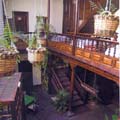History.
 Archaeological remains have been discovered that hint at the aborigine presence before the conquest. After the conquest finished in 1506 the construction of a pier was ordered in La Orotava, at that time the population was scarce and dedicated to commercial activities. A hundred years later it was granted a licence by the Guildhall of La Laguna to Franchy Lutzardo for "forming a population, signalling areas, streets and building a church with its plaza".
Archaeological remains have been discovered that hint at the aborigine presence before the conquest. After the conquest finished in 1506 the construction of a pier was ordered in La Orotava, at that time the population was scarce and dedicated to commercial activities. A hundred years later it was granted a licence by the Guildhall of La Laguna to Franchy Lutzardo for "forming a population, signalling areas, streets and building a church with its plaza".
The parochial church under the name Our Lady of the La Peña de Francia was built in 1603.
When the sugar cane plantations began to weaken, the monoculture of certain grapevinestalks for wine production flourished, increasing produce exports to England more than 85 %, which prompted English business men to establish themselves in the region.
The development of its harbour boomed in 1706 after the volcanic eruption that destroyed the harbour of Garachico, in this way increasing the place’s prosperity by carrying out considerable urban transformations and public works, reaching its municipal independence in 1722.
With the construction of the Taoro hotel, by initiative of a group of banana business men, a titanic work from the second half of the XIX century, in which no one, except the partners and members of the contracted services, could enter; and later with the construction of the Monopol hotel and the Marquesa, a nucleus was formed that gave rise to the present day tourist area of this city.
The displacement of the maritime traffic towards the harbour of Santa Cruz de Tenerife and its development, together with the monoculture’s crisis, initiates the vertiginous decline of this municipality until the middle of the XX century, when tourism became the main basis of its economy.
 Places of Historical Interest
Places of Historical Interest
Los Hermanos de La Cruz Blanca House
Phone: 922 384 079
Ancient house of the Pasley
Royal Customs House (Casa Real de La Aduana)
Founded in 1620, next to it is the harbour with its pier.
Luis de La Cruz y Ríos Birth House
La Cherche English Cemetery
Year 1757
Temple of Lomo Nieves
Ancient Casino
Church of Our Lady of La Peña de Francia
A temple from the beginning of the XVII century. The influence of the Irish families that arrived at Puerto de La Cruz, is reflected in the Chapel of San Patricio. With a neoclassic tower from the XIX century and Moresque panelling, inside it features a baroque altarpiece from the XVII century on its main altar.
Temple of San Telmo
Founded in 1780 by the Mareantes gild and dedicated to the name of the Dominican priest San Pedro González Telmo. Moresque roofing.
Botanical Gardens
The Acclimatising Garden of La Orotava, created at the end of the XVIII century, to acclimate plants from different places around the world, with final destiny in Europe. A great number of plant species corresponding to tropical and equatorial regions, were allowed to concentrate in this area. In this way a place of great scientific and didactic interest was created, with valuable architectural and sculptural pieces, as well as pictorial and urban arts.
La Casona and San Fernando Gardens
In this place the first primate studies were carried out.
Church of San Francisco
Previously the convent of San Juan Bautista, it was built in the first decade of the XVII century in the same place as the temple before it.
Church of San Amaro
Located in the urban area, it dates back to the XVII century and is done in Canary style. Inside there is an image of the Virgin of Peace (Virgen de la Paz).
 Miranda House
Miranda House
Second half of the XVIII century, today it is occupied by a typical restaurant.
San Felipe Castle
A coast fortress, it was built between 1630 and 1644 to defend the entrance of the old harbour and the inhabited areas from pirate attacks.